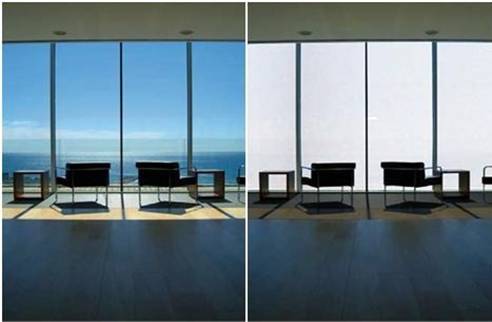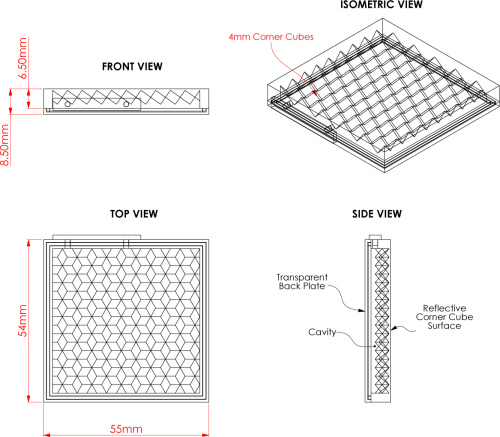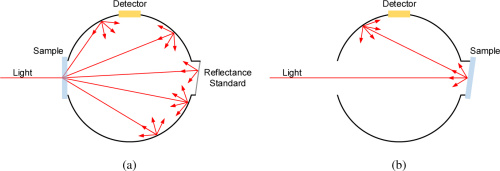
Smart glass allows control over light transmission for climate adaptability. Courtesy of Glass Apps Source.
Researchers at the University of Delaware have revealed an exciting opportunity for the market of energy efficient technologies. In a paper published in February’s issue of Optics Express, the team outlines their novel optofluidic smart glass prototype that outperforms many current commercially available technologies. The new model promises a much more energy-efficient and cost-effective option for the future of smart building design.
What is smart glass? Why is it important?
Climate-adaptive technologies have become increasingly important in the past decade. According to an ACEEE Study on energy efficiency in buildings, static windows account for about 30% of a building’s heating and cooling energy. Smart glass essentially transitions from translucent to transparent- blocking certain wavelengths of light or permitting light through. The windows curb the effects of solar radiation by altering light transmission properties dependent on the current climate. This ultimately saves costs on lighting, heating, and air-conditioning. Critical parameters of current smart glass technology includes degree of transparency, material and installation costs, and durability.
The Current Market for Smart Glass
Three technologies currently drive the switchable glass market: chromic materials, suspended particle devices, and liquid crystals. According to the research team, while these options do successfully block UV rays, “cost and intricate manufacturing processes still remain a challenge for the smart glass industry.”
Each method struggles with unique effects of its own makeup. A few of the most costly problems include high solar absorbance, high power consumption due to a constantly emitting electric field, and questionable long-term stability. All three techniques use transparent conductors (TC) typically composed of tin-doped indium oxide (In2O3) to “switch” the glass. Indium, however, struggles to meet demand because it is moderately expensive and rare. TC films also suffer from scattering losses and hazing which reduces transmittance abilities. The market requires a new design that maintains a high transmission efficiency at low cost.
The research team at the forefront of the solution includes Daniel Wolfe and K.W. Goossen. The proposal involves a square-shaped cavity containing a pattern of corner cube reflectors, an intercepting fluid, and a transparent plate backing.

The above schematic shows the corner cube pattern and cavity for fluid. Courtesy of OSA publishing
Theory Behind the Operation of Smart Glass
The design utilizes total internal reflection and refractive index matching to allow for tailored transmission, reflection, and absorption. Light enters the device and is incident on the corner cube pattern. This pattern results in retroreflection, meaning no matter at what angle it hits, the light will reflect back at the source. Once retroreflected, the light enters a fluid where it is subject to a variable refractive index. As the refractive index of the fluid increases to meet that of the surrounding material, refraction will decrease while transmission increases. This provides control over refractive and transmission modulation.

The above diagram shows how the light hits the sample device in the integrating sphere for testing. Courtesy of OSA publishing.
The Results
The researchers took spectrophotometer readings by incorporating an integration sphere to act as a chamber for entering light, the device, and a detector. They ran tests on their device by filling it with air, water, and methyl salicylate. Their results show the 3D printed prototype is capable of modulating light transmittance from 8% when filled with air all the way to 85% when filled with the methyl salicylate.
The University of Delaware team sought to create a cheaper, more efficient smart glass prototype, and they have exceeded expectations. Their device is not only less expensive, but it provides a larger transmission modulation range than those that are commercially available. For reference, most liquid crystal devices attain a range from 50%-80%. Wider transmission range means better adaptability.

The above images depict the variable transmittance through air, water, and methyl salicylate respectively. Courtesy of OSA publishing.
According to the U.S. Energy Information Administration, energy consumption will increase 45% for electricity and 62% for natural gas in the next 20 years. Low-power-consuming technologies have become an essential feature of the modern world. The optofluidic smart glass prototype devised by Wolfe and Goossen has shown to be an impactful improvement of the currently available devices. Both less expensive and more energy-efficient, the design could be a serious contender in the green technologies market.
For more information on their ground-breaking design, check out their paper here.
